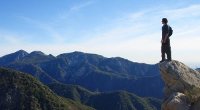Hiking Speed and Trail Steepness
-
Ze Hiker

- Posts: 1432
- Joined: Mon Jul 28, 2008 7:14 pm
For anyone interested in a little GPS analysis, I did a little study on the relationship between trail steepness and hiking speed.
-
turtle

- Posts: 152
- Joined: Wed Jan 27, 2010 11:35 am
Very cool... I've always wanted to see something like this.
A related question that I think your data can answer...
What's the most efficient grade of trail for gaining elevation? That is, given that you are working at full capacity, what grade of trail will get you up a certain height the fastest?
Perhaps a new plot with a y-axis of upward velocity will provide the answer. A good approximation of this (for low angles) can be attained by simply multiplying the current y-values (horizontal speed) by the current x-values (grade).
A related question that I think your data can answer...
What's the most efficient grade of trail for gaining elevation? That is, given that you are working at full capacity, what grade of trail will get you up a certain height the fastest?
Perhaps a new plot with a y-axis of upward velocity will provide the answer. A good approximation of this (for low angles) can be attained by simply multiplying the current y-values (horizontal speed) by the current x-values (grade).
-
hamik

- Posts: 77
- Joined: Fri Jan 22, 2010 2:50 pm
I'd also be interested in running the data for vertical velocity. An interesting property of this graph is that fitness will scale it vertically and probably only affect it a little horizontally; in other words, you will see an optimum angle plus or minus a few degrees.
v_v = v_diag * sin(arctan grade), preferably plotted against theta
Anecdotally, one can absolutely fly up vertical terrain provided it is conducive to human movement (sometimes on the lower glaciers in the Alps, there are ladders for descending and ascending glacially polished rock on their flanks, and people move very, very fast on these). Think also about vertical ascent rates on a long flight of stairs. Basically, the optimum angle of ascent is a significant function of human ability to walk or climb on the surface--it's much easier to run up a flight of stairs than it is to french technique up a 40 degree slope, for instance.
In the limit case of human power translated perfectly into locomotion along a ladder of varying degrees, I think that vertical efficiency would be monotonic increasing with the angle of the ladder. Your data and model are more relevant to actual hiking, though, which is why I'd be interested in seeing the graph I mentioned.
v_v = v_diag * sin(arctan grade), preferably plotted against theta
Anecdotally, one can absolutely fly up vertical terrain provided it is conducive to human movement (sometimes on the lower glaciers in the Alps, there are ladders for descending and ascending glacially polished rock on their flanks, and people move very, very fast on these). Think also about vertical ascent rates on a long flight of stairs. Basically, the optimum angle of ascent is a significant function of human ability to walk or climb on the surface--it's much easier to run up a flight of stairs than it is to french technique up a 40 degree slope, for instance.
In the limit case of human power translated perfectly into locomotion along a ladder of varying degrees, I think that vertical efficiency would be monotonic increasing with the angle of the ladder. Your data and model are more relevant to actual hiking, though, which is why I'd be interested in seeing the graph I mentioned.
-
turtle

- Posts: 152
- Joined: Wed Jan 27, 2010 11:35 am
I believe that Ze's vertical axis is currently horizontal velocity, no? I assume he's pulling data from a GPS unit, which would presumably give you only the component of the velocity along the surface of the earth.hamik wrote: v_v = v_diag * sin(arctan grade), preferably plotted against theta
That sounds just like Iron Mountain where Ze gathered his data.hamik wrote: Anecdotally, one can absolutely fly up vertical terrain provided it is conducive to human movement ... glacially polished rock on their flanks, and people move very, very fast on these).
But yes, surely the results of the graph we're proposing will depend strongly on the nature of the terrain. Glacial polish? Sand dunes? Stable ledges? Scree? Firm dirt trailbed? Firm snow? Deep snow?
Ze, another suggestion... the data from the GPS is quite noisy, of course. (I'm assuming that speed and grade are calculated using only a pair of adjacent data points.) I wonder if it would be possible to filter it to good effect?
-
Ze Hiker

- Posts: 1432
- Joined: Mon Jul 28, 2008 7:14 pm
Yes I agree with both of you on the vertical. I have plotted that actually, I'll be posting that next. I agree that the mechanics will change, but especially if one changes the terrain (steep slope with good friction, crumbly, stairs, climbing). But for this data set and span of grades I think those factors aren't too big (well mechanics do change).
In terms of the actual calculation, of course I directly have vertical data so no need to calculate. But I also derive it from the equation I generated from this current graph. This graph shows horizontal velocity, and grade is defined as rise over run, so it is correct I just need to multiply X * Y to get vertical velocity. (but I don't think it only works at low grades, it should work for all).
In terms of the actual calculation, of course I directly have vertical data so no need to calculate. But I also derive it from the equation I generated from this current graph. This graph shows horizontal velocity, and grade is defined as rise over run, so it is correct I just need to multiply X * Y to get vertical velocity. (but I don't think it only works at low grades, it should work for all).
-
Ze Hiker

- Posts: 1432
- Joined: Mon Jul 28, 2008 7:14 pm
Yes I am filtering...I have a few different filter cutoffs and I look at them all, just presenting one. I could smooth the data more for perhaps a more clear trend, especially since both measures are derivatives of the raw data and therefore highly sensitive to error.turtle wrote:
Ze, another suggestion... the data from the GPS is quite noisy, of course. (I'm assuming that speed and grade are calculated using only a pair of adjacent data points.) I wonder if it would be possible to filter it to good effect?
of course filtering itself is worth a whole post!
-
jimqpublic
- Posts: 58
- Joined: Mon Dec 15, 2008 10:05 am
Are your vertical values exagerated or are you really hiking on 60% grades?
Edit: is there possible exageration due to imprecision of GPS vertical?
Edit: is there possible exageration due to imprecision of GPS vertical?
-
Ze Hiker

- Posts: 1432
- Joined: Mon Jul 28, 2008 7:14 pm
Have you ever hiked up Iron Mt?jimqpublic wrote:Are your vertical values exagerated or are you really hiking on 60% grades?
Edit: is there possible exageration due to imprecision of GPS vertical?
But you are right, there is certainly imperfection in not only the GPS vertical, but also horizontal. And more smoothing would reduce the amount of points calculated with a high grade.
With Iron Mt, there are surely points on that trail that are realistically above 40% grade, I'd have to look at the data, then compare across different smoothing values. I'll look into that. I'm sure there is some level of error, but I think the general trend stands.
-
Taco

- Snownado survivor
- Posts: 6136
- Joined: Thu Sep 27, 2007 4:35 pm
NOOO! PROGRAMMING!!! NUMBERS!!!!

end

end
-
platypii

- Posts: 55
- Joined: Mon Jan 26, 2009 4:58 am
Arg, I just posted a comment to Ze's blog before I read the replys here. Turns out you all had the same idea as me, but first 
I think Hamik is right that steeper is always better, as long as you can still move efficiently over the terrain. At some point you enter the realm of technical rock climbing and I think rewards would start to diminish, probably as soon as the rope comes out...platypii wrote:Really cool stuff Ze!! I might have to invest in a GPS just to play with this kind of data!
What would be really interesting is, given an individual's data, to determine their optimal hiking grade for a given altitude gain.
For example, consider Mt Whitney with the Main Mt Whitney Trail vs the Mountaineer's Route.
MMWT: 6000ft in 11mi, grade = 0.10
MR: 6000ft in 5mi, grade = 0.23
Estimated times, based on your data:
MMWT: 11mi @ 4mph = 2.75 hours
MR: 5mi @ 2.5mph = 2 hours
I think it's clear those numbers should be higher due to elevation (next graph: altitude vs speed?), but it would be interesting to see where the "sweet spot" is, to help with route selection, and determine how steep to make switchbacks when in the backcountry.
-
Ze Hiker

- Posts: 1432
- Joined: Mon Jul 28, 2008 7:14 pm
lol no its good to comment on the blog, makes it seem like someone is reading it! 
I agree. I have some plots. I'll put something together on it soon.
I agree. I have some plots. I'll put something together on it soon.
-
spotfin
- Posts: 53
- Joined: Fri Jan 01, 2010 2:30 pm
Fascinating stuff and I admire your ability to figure this out, but this song keeps popping into my head, "too much time on my hands". 
-
jimqpublic
- Posts: 58
- Joined: Mon Dec 15, 2008 10:05 am
Since recently getting a GPS receiver I'm amazed just how fast I move, when I'm moving. It's also amazing how much time I spend standing around. I haven't recorded enough hikes to come up with meaningful analysis. Clearly though I move much slower than you guys.
Pre-GPS my simple formula for route planning was this: 20 minutes per mile + 60 minutes per thousand feet gain + 30 minutes per thousand foot loss. Gradual downhills increase my speed but steep ones slow me down. It usually matched within reason on the JMT two years ago.
So for me, Whitney via Main Trail ought to take 9 hours and back down ought to take 4.
From Guitar Lake (6 miles, 3000' gain) should take 5 hours to the summit, 4 hours to the store, for 9 hours total. I guess I was feeling my oats that day because I took only three hours up, but going down was about 4.
Regarding trail steepness, there's more to it than biodynamic efficiency. Much above 10% and erosion becomes a major issue. Above 20% and they need to go to steps.
Then there are the knees of us hikers. They prefer a more gradual ascent.
Pre-GPS my simple formula for route planning was this: 20 minutes per mile + 60 minutes per thousand feet gain + 30 minutes per thousand foot loss. Gradual downhills increase my speed but steep ones slow me down. It usually matched within reason on the JMT two years ago.
So for me, Whitney via Main Trail ought to take 9 hours and back down ought to take 4.
From Guitar Lake (6 miles, 3000' gain) should take 5 hours to the summit, 4 hours to the store, for 9 hours total. I guess I was feeling my oats that day because I took only three hours up, but going down was about 4.
Regarding trail steepness, there's more to it than biodynamic efficiency. Much above 10% and erosion becomes a major issue. Above 20% and they need to go to steps.
Then there are the knees of us hikers. They prefer a more gradual ascent.
